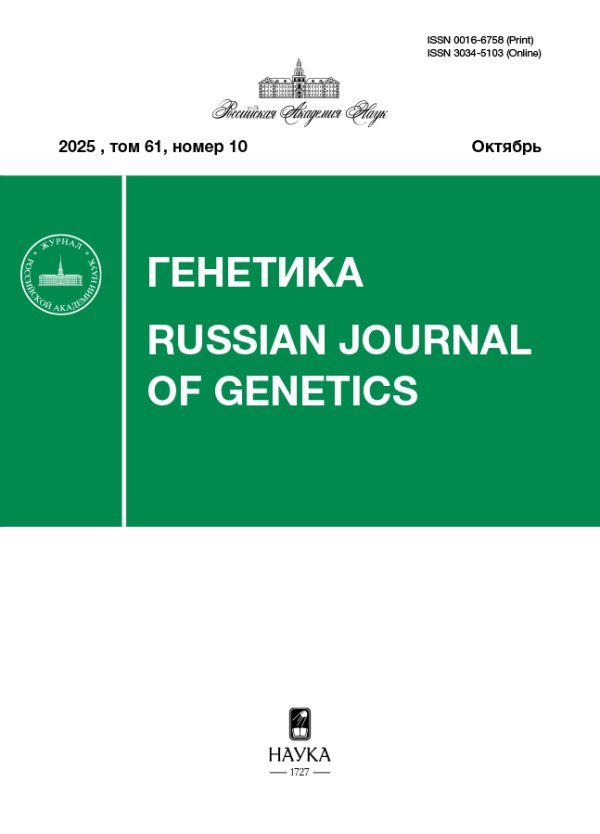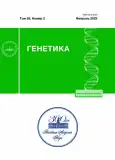Структура и разнообразие ДНК-транспозонов Tc1/mariner в геноме ушастой медузы Aurelia aurita
- Авторы: Улупова Ю.Н.1, Пузакова Л.В.1, Пузаков М.В.1
-
Учреждения:
- Федеральный исследовательский центр “Институт биологии южных морей им. А.О. Ковалевского” Российской академии наук
- Выпуск: Том 59, № 2 (2023)
- Страницы: 147-156
- Раздел: МОЛЕКУЛЯРНАЯ ГЕНЕТИКА
- URL: https://journals.rcsi.science/0016-6758/article/view/134552
- DOI: https://doi.org/10.31857/S0016675823020133
- EDN: https://elibrary.ru/KYLGLQ
- ID: 134552
Цитировать
Полный текст
Аннотация
Мобильные генетические элементы – ДНК-транспозоны и ретротранспозоны – это последовательности ДНК, способные к перемещениям внутри генома. Предполагается, что они играют одну их ключевых ролей в адаптивных и эволюционных процессах. Одной из наиболее изученных групп ДНК-транспозонов является инфракласс ITm и, в частности, суперсемейство Tc1/mariner. В настоящей работе мы рассмотрели представленность, структуру и эволюцию ДНК-транспозонов Tc1/mariner ушастой медузы Aurelia aurita. Было установлено, что преобладающая доля элементов Tc1/mariner медузы представлена семейством TLE. Выявлено новое подсемейство элементов TLE, названное Aurum. Кроме того, в семействе Visitor обнаружены две группы элементов VS-aura и VS-beplau, которые, вероятно, также являются отдельными подсемействами. Анализ структуры и разнообразия элементов Tc1/mariner показал, что в настоящий момент транспозоны Tc1/mariner в геноме медузы находятся на стадии деградации и элиминации. Практически все элементы делетированы или имеют структурные изменения и соответственно не имеют потенциально функциональных копий.
Ключевые слова
Об авторах
Ю. Н. Улупова
Федеральный исследовательский центр “Институт биологии южных морейим. А.О. Ковалевского” Российской академии наук
Email: puzakov@ngs.ru
Россия, 299011, Севастополь
Л. В. Пузакова
Федеральный исследовательский центр “Институт биологии южных морейим. А.О. Ковалевского” Российской академии наук
Email: puzakov@ngs.ru
Россия, 299011, Севастополь
М. В. Пузаков
Федеральный исследовательский центр “Институт биологии южных морейим. А.О. Ковалевского” Российской академии наук
Автор, ответственный за переписку.
Email: puzakov@ngs.ru
Россия, 299011, Севастополь
Список литературы
- McClintock B. Chromosome organization and genetic expression // Cold Spring Harbor Symp. Quant. Biol. 1951. V. 16. P. 13–47. https://doi.org/10.1101/sqb.1951.016.01.004
- Guo B., Zou M., Gan X., He S. Genome size evolution in pufferfish: an insight from BAC clone-based Diodon holocanthus genome sequencing // BMC Genomics. 2010. V. 11. P. 396. https://doi.org/10.1186/1471-2164-11-396
- Feschotte C., Pritham E.J. DNA transposons and the evolution of eukaryotic genomes // Annu. Rev. Genet. 2007. V. 41. P. 331–368. https://doi.org/10.1146/annurev.genet.40.110405.090448
- Bourque G., Burns K.H., Gehring M. et al. Ten things you should know about transposable elements // Genome Biology. 2018. V. 19. № 1. P. 199. https://doi.org/10.1186/s13059-018-1577-z
- Piacentini L., Fanti L., Specchia V. et al. Transposons, environmental changes, and heritable induced phenotypic variability // Chromosoma. 2014. V. 123. № 4. P. 345–354. https://doi.org/10.1007/s00412-014-0464-y
- Kojima K.K. Structural and sequence diversity of e-ukaryotic transposable elements // Genes Genet. Syst. 2020. V. 94. P. 233–252. Epub. 2018. Nov. 9.https://doi.org/10.1266/ggs.18-00024
- Dupeyron M., Baril T., Bass C., Hayward A. Phylogenetic analysis of the Tc1/mariner superfamily reveals the unexplored diversity of pogo-like elements // Mobile DNA. 2020. V. 11. P. 21. https://doi.org/10.1186/s13100-020-00212-0
- Gao B., Wang Y., Diaby M. et al. Evolution of pogo, a separate superfamily of IS630-Tc1-mariner ransposons, revealing recurrent domestication events in vertebrates // Mobile DNA. 2020. V. 11. P. 25. https://doi.org/10.1186/s13100-020-00220-0
- Lee C.C., Wang J. Rapid expansion of a highly germline-expressed Mariner element acquired by horizontal transfer in the fire ant genome // Genome Biol. Evol. 2018. V. 10. № 12. P. 3262–3278. https://doi.org/10.1093/gbe/evy220
- Xie L.Q., Wang P.L., Jiang S.H. et al. Genome-wide identification and evolution of TC1/Mariner in the silkworm (Bombyx mori) genome // Genes Genomics. 2018. V. 40. № 5. P. 485–495. https://doi.org/10.1007/s13258-018-0648-6
- Shen D., Gao B., Miskey C. et al. Multiple invasions of visitor, a DD41D family of Tc1/mariner transposons, throughout the evolution of vertebrates // Genome Biol. Evol. 2020. V. 12. № 7. P. 1060–1073. https://doi.org/10.1093/gbe/evaa135
- Claudianos C., Brownlie J., Russell R. et al. maT – a clade of transposons intermediate between mariner and Tc1 // Mol. Biol. Evol. 2002. V. 19. № 12. P. 2101–2109. https://doi.org/10.1093/oxfordjournals.molbev.a004035
- Zhang H.H., Shen Y.H., Xiong X.M. et al. Identification and evolutionary history of the DD41D transposons in insects // Genes Genomics. 2016. V. 38. P. 109–117. https://doi.org/10.1007/s13258-015-0356-4
- Ivics Z., Izsvák Z. Sleeping Beauty transposition // Microbiol. Spectrum. 2015. V. 3. № 2. MDNA3-0042-2-14. https://doi.org/10.1128/microbiolspec.MDNA3-0042-2014
- Ivics Z., Hackett P.B., Plasterk R.H., Izsvák Z. Molecular reconstruction of Sleeping Beauty, a Tc1-like transposon from fish, and its transposition in human cells // Cell. 1997. V. 91. № 4. P. 501–510. https://doi.org/10.1016/s0092-8674(00)80436-5
- Plasterk R.H., Izsvák Z., Ivics Z. Resident aliens: the Tc1/mariner superfamily of transposable elements // Trends in Genet. 1999. V. 15. № 8. P. 326–332. https://doi.org/10.1016/s0168-9525(99)01777-1
- Tellier M., Bouuaert C.C., Chalmers R. Mariner and the ITm superfamily of transposons // Microbiol. Spectrum. 2015. V 3. № 2. MDNA3-0033-2014. https://doi.org/10.1128/microbiolspec.MDNA3-0033-2014
- Shi S., Puzakov M., Guan Z. et al. Prokaryotic and eukaryotic horizontal transfer of Sailor (DD82E), a new superfamily of IS630-Tc1-mariner DNA transposons // Biology (Basel). 2021. V. 10. № 10. P. 1005. https://doi.org/10.3390/biology10101005
- Wang S., Diaby M., Puzakov M. et al. Divergent evolution profiles of DD37D and DD39D families of Tc1/mariner transposons in eukaryotes // Mol. Phylogenet. Evol. 2021. V. 161. P. 107143. https://doi.org/10.1016/j.ympev.2021.107143
- Shao H., Tu Z. Expanding the diversity of the IS630-Tc1-mariner superfamily: Discovery of a unique DD37E transposon and reclassification of the DD37D and DD39D transposons // Genetics. 2001. V. 159. № 3. P. 1103–1115. https://doi.org/10.1093/genetics/159.3.1103
- Puzakov M.V., Puzakova L.V., Cheresiz S.V. An analysis of IS630/Tc1/mariner transposons in the genome of a Pacific oyster, Crassostrea gigas // J. Mol. Evol. 2018. V. 86. № 8. P. 566–580. https://doi.org/10.1007/s00239-018-9868-2
- Lawley J.W., Gamero-Mora E., Maronna M.M. et al. The importance of molecular characters when morphological variability hinders diagnosability: Systematics of the moon jellyfish genus Aurelia (Cnidaria: Scyphozoa) // Peer J. 2021. V. 9. e11954. https://doi.org/10.7717/peerj.11954
- Dawson M.N., Sen Gupta A., England M.H. Coupled biophysical global ocean model and molecular genetic analyses identify multiple introductions of cryptogenic species // Proc. Natl Acad. Sci. USA. 2005. V. 102. P. 11968–11973. https://doi.org/10.1073/pnas.0503811102
- Луппова Н.Е. Динамика численности и биомассы популяций черноморского макрозоопланктона // Бюл. науки и практики. 2020. Т. 6. № 5. С. 74–82. https://doi.org/10.33619/2414-2948/54/09
- Zhang H.H., Li G.Y., Xiong X.M. et al. TRT, a vertebrate and protozoan Tc1-like transposon: Current activity and horizontal transfer // Genome Biol. Evol. 2016. V. 8. № 9. P. 2994–3005. https://doi.org/10.1093/gbe/evw213
- Sang Y., Gao B., Diaby M. et al. Incomer, a DD36E family of Tc1/mariner transposons newly discovered in animals // Mobile DNA. 2019. V. 10. P. 45. https://doi.org/10.1186/s13100-019-0188-x
- Zong W., Gao B., Diaby M. et al. Traveler, a new DD35E family of Tc1/mariner transposons, invaded vertebrates very recently // Genome Biol. Evol. 2020. V. 12. № 3. P. 66–76. https://doi.org/10.1093/gbe/evaa034
- Gao B., Zong W., Miskey C. et al. Intruder (DD38E), a recently evolved sibling family of DD34E/Tc1 transposons in animals // Mobile DNA. 2020. V. 11. № 1. P. 32. https://doi.org/10.1186/s13100-020-00227-7
- Zhang Z., Schwartz S., Wagner L.W. et al. A greedy algorithm for aligning DNA sequences // J. Computational Biol. 2000. V. 7. № 1–2. P. 203–214. https://doi.org/10.1089/10665270050081478
- De Castro E., Sigrist C.J., Gattiker A. et al. ScanProsite: Detection of PROSITE signature matches and ProRule-associated functional and structural residues in proteins // Nucl. Acids Res. 2006. V. 34. P. W362–W365. https://doi.org/10.1093/nar/gkl124
- Buchan D.W., Minneci F., Nugent T.C. et al. Scalable web services for the PSIPRED Protein Analysis Workbench // Nucl. Acids Res. 2013. V. 41 (W1). P. W349–W357. https://doi.org/10.1093/nar/gkt381
- Edgar R.C. MUSCLE: A multiple sequence alignment method with reduced time and space complexity // Nucl. Acids Res. 2004. V. 32. P. 1792–1797. https://doi.org/10.1093/nar/gkh340
- Kumar S., Stecher G., Tamura K. MEGA7: Molecular evolutionary genetics analysis version 7.0 for bigger datasets // Mol. Biol. Evol. 2016. V. 33. № 7. P. 1870–1874. https://doi.org/10.1093/molbev/msw054
- Пузаков М.В., Пузакова Л.В. Распространенность, разнообразие и эволюция ДНК-транспозонов L18 (DD37E) в геномах стрекающих (Cnidaria) // Мол. биология. 2022. Т. 56. № 3. С. 1–15 https://doi.org/10.31857/S0026898422030120
- Puzakov M.V., Puzakova L.V., Cheresiz S.V., Sang Y. The IS630/Tc1/mariner transposons in three ctenophore genomes // Mol. Phylogenet. Evol. 2021. V. 163. P. 107231. https://doi.org/10.1016/j.ympev.2021.107231
- Bouallègue M., Filée J., Kharrat I. et al. Diversity and evolution of mariner-like elements in aphid genomes // BMC Genomics. 2017. V. 18. № 1. P. 494. https://doi.org/10.1186/s12864-017-3856-6
- Benjamin B., Yves B., Corinne A.G. Assembly of the Tc1 and mariner transposition initiation complexes depends on the origins of their transposase DNA binding domains // Genetica. 2007. V. 130. № 2. P. 105–120. https://doi.org/10.1007/s10709-006-0025-2
- Gomulski L.M., Torti C., Bonizzoni M. et al. A new basal subfamily of mariner elements in Ceratitis rosa and other tephritid flies // J. Mol. Evol. 2001. V. 53. № 6. P. 597–606. https://doi.org/10.1007/s002390010246
- Robertson H.M., Lampe D.J. Distribution of transposable elements in arthropods // Annual Rev. Entomol. 1995. V. 40. P. 333–357. https://doi.org/10.1146/annurev.en.40.010195.002001
- Jacobson J.W., Medhora M.M., Hartl D.L. Molecular structure of a somatically unstable transposable element in Drosophila // Proc. Natl Acad. Sci. USA. 1986. V. 83. № 22. P. 8684–8688. https://doi.org/10.1073/pnas.83.22.8684
- Emmons S.W., Yesner L. High-frequency excision of transposable element Tc1 in the nematode Caenorhabditis elegans is limited to somatic cells // Cell. 1984. V. 36. № 3. P. 599–605. https://doi.org/10.1016/0092-8674(84)90339-8
- Eide D., Anderson P. Transposition of Tc1 in the nematode Caenorhabditis elegans // Proc. Natl Acad. Sci. USA. 1985. V. 82. № 6. P. 1756–1760. https://doi.org/10.1073/pnas.82.6.1756
- Guo X.M., Zhang Q.Q., Sun Y.W. et al. Tc1-like transposase Thm3 of silver carp (Hypophthalmichthys molitrix) can mediate gene transposition in the genome of blunt snout bream (Megalobrama amblycephala) // G3: Genes, Genomes, Genetics. 2015. V. 5. № 12. P. 2601–2610. https://doi.org/10.1534/g3.115.020933
- Puzakov M.V., Puzakova L.V., Cheresiz S.V. The Tc1-like elements with the spliceosomal introns in mollusk genomes // Mol. Genet. Genomics. 2020. V. 295. № 3. P. 621–633. https://doi.org/10.1007/s00438-020-01645-1
- Capy P., Vitalis R., Langin T. et al. Relationships between transposable elements based upon the integrase-transposase domains: is there a common ancestor? // J. Mol. Evol. 1996. V. 42. № 3. P. 359–368. https://doi.org/10.1007/BF02337546
Дополнительные файлы












